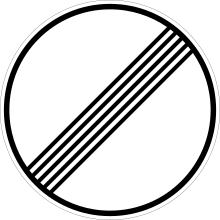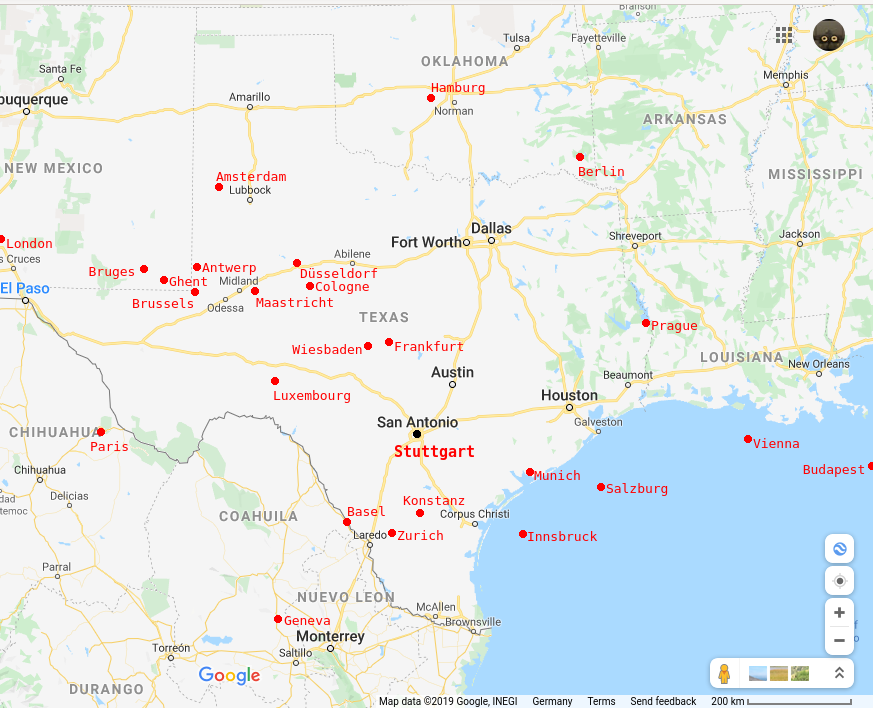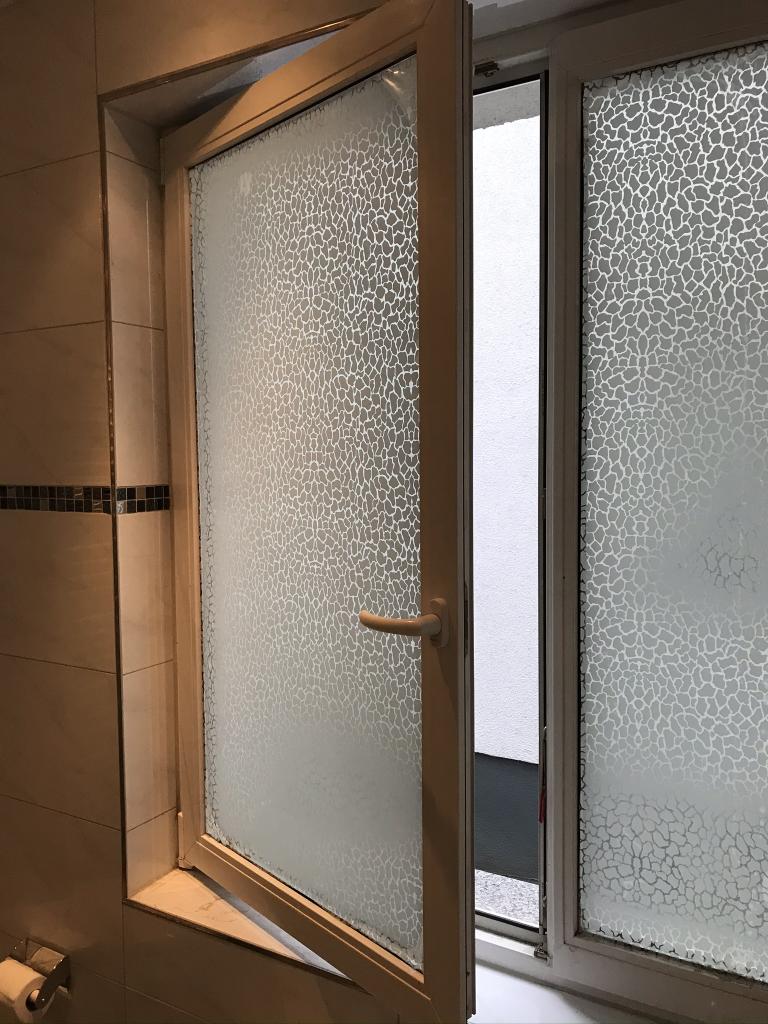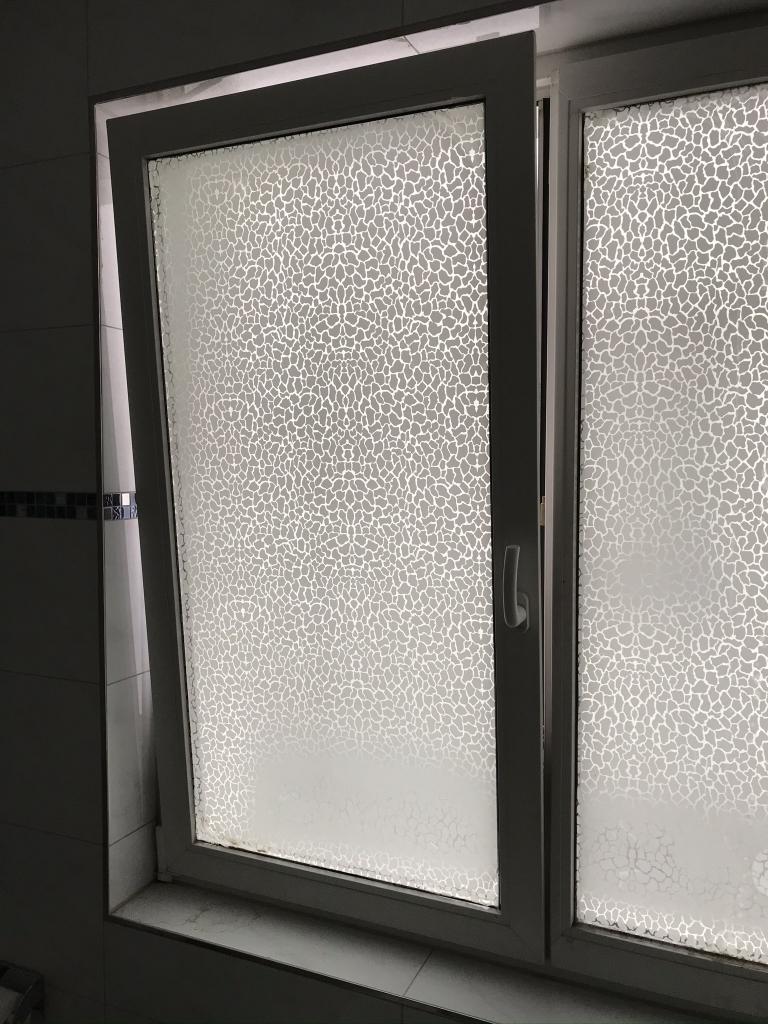After a year and a half living in Germany, I really felt I should exhaustively write out all my observations on life over here. Overall, I've really loved it, and while there's been a lot of culture shock, there's also been more moments than I can count in which I've thought "why can't we have anything like this back in the States?" Before moving here, I was in San Antonio, Texas for eight years, and before that, spent various stages of life moving between three coasts and a few other points far from any coast.
I have to point out, first, that I can't comment on anything like the German economy, health care, or anything like that; I'm still a US citizen working for the US government getting paid US dollars, out of which are drawn US taxes, in my US bank account. All I know about German taxes, income levels, etc. I only know from a few videos and articles I've seen, so I'm not really qualified to say anything about any of that.
First, living conditions. The apartment I live in is, I think, about 2/3 the size of the one I used to live in back in San Antonio. It occupies one floor of a rather large three story house, a pretty common situation over here. The rent I pay is about twice what I was paying in San Antonio. This may have seemed jarring at first, but to keep it in perspective, it could be worse; if you Google "San Francisco median rent" you'll see a lot of numbers that are much bigger than my monthly rent here. Living in a smaller space has also helped me to downsize and determine what stuff is really worth keeping.
Speaking of rent, it's calculated a little different than in the States. If you're looking for an apartment in Germany, you must be aware: the first rent figure you see will be labeled Kaltmiete, which literally means "cold rent." That's the base monthly payment, NOT including utilities, which may be between 200€ and 300€. Kaltmiete plus utilities is your Warmmiete, "warm rent." As in the States, this does not include your electric bill which is separate.
Another word you need to know is Einbauküche, "built-in kitchen." It seems it's pretty common over here to build apartments without kitchen fixtures. No stove, oven, fridge, or even a sink! In such apartments one has to buy those things and have someone install it all. If you don't want to go through all that hassle, look for advertisements which include the word Einbauküche.
I should also add that while water, as a utility, is more expensive in Europe than in the US, one doesn't usually pay more because Europeans use less. Turn on a hot water faucet in Europe, and hot water comes out within seconds. In America, you have to wait several minutes before the hot water comes out. Since we have to do this several times every day, just think of all the untold gallons of water every American wastes every year because of how our water heaters are configured.
Air conditioning is almost never found in homes and apartments. This isn't really a problem, because it rarely ever gets hot enough to need it. In recent years, however, Europe has been getting hit with increasingly stifling heat waves during the height of summer. The heat feels like San Antonio, except it only lasts for a week or two instead of three months. During these hot weeks I've been able to cope by opening all my windows during the night, when it's cool out, and then closing them during the day to keep the cool air in with fans circulating it. There's also no central heating units; during the winter, you keep your place warm by turning on the radiators which are typically in every room.
The housing situation varies widely between different countries and cities in Europe. According to this, 57% of Germans live in apartments while only 14% of British people do. I can believe that; when I look around Germany I mostly see buildings not unlike the one I live in, houses containing three or four apartments each, usually one per floor. While waiting for a bus in Chelsea, London, however, I felt like I was in Brooklyn, surrounded as I was by row after endless row of brownstone homes.
Convenient Living
On the whole, it's a lot easier to live in a more convenient location over here than it is in the States. I was extremely lucky to find an apartment here in the perfect location: ten minute bike ride to work, with a couple grocery stores, some bars and restaurants, and the U/S-Bahn station all within a ten minute walk. Compare that with my San Antonio apartment, where it may have taken ten minutes to walk to a strip mall, Family Dollar, and Schlotszky's in one direction, and a convenience store and a bus stop in the other, but it felt like a lot longer because of all the empty space in between.
It's also pretty common over here to find corner stores which are just like convenience stores but also have plenty of fresh produce, i.e. fruits and vegetables. Not just one little rack but whole shelves full of apples, bananas, pears, tomatoes, carrots, cucumbers...is this even legal in the States? I only recall encountering one in Texas, and that was in a mostly isolated housing development outside Austin. I actually don't use them much over here since I can just walk to a supermarket in less than ten minutes, but they've been real convenient while traveling.
I should add that not everyone over here has it so easy; I have found myself in neighborhoods in which the only things within walking distance from most houses were other houses and maybe a local bakery, and there are plenty of people who live out in the sticks and need a car for most errands. It's still not as common a situation as in the US. And on the flip side, there are plenty of convenient places to live in the States, and I'm not just talking about million-dollar gentrified enclaves like Bushwick, Brooklyn or trendy developments like SA's Pearl. You just need to know where to look. When I move back I may not be able to bike to work anymore, but I don't plan on giving up living so close to a supermarket.
Public Transit
Public transport is, generally, way better than in the States. That is not to say that all public transport in the States is crap--I thought Seattle's, among others, was pretty good--but on average European cities do it better.
Pretty much every settlement larger than a village has a bus system, and sometimes trams, which I rarely use because I'm usually OK with walking the short distances they're mostly used for. Anything that could be considered a "big city" has an U-Bahn system. In a handful of big cities, like Berlin, Munich, and Hamburg, the U-Bahn is a subway little different from NYC's or Toronto's. In most other cities, however (Stuttgart, Cologne, Düsseldorf, etc.), the U-Bahn is a light rail network like Dallas' or Seattle's, in which the trains are smaller and have fewer cars than a subway's, and they only go underground downtown.
Major metro areas also have a commuter rail system called "S-Bahn" operated jointly by Deutsche Bahn and the local transit authority. The purpose of an S-Bahn is to connect suburbs and exurbs to the big city, so S-Bahn networks will be further-flung than U-Bahn, and make fewer stops downtown. And because of how close together some big cities are (more on that later), you can often find two or more big cities connected by the same S-Bahn network, Cologne and Düsseldorf for example. If, like me, you're lucky enough to live close enough to a station, you can get downtown pretty easy while leaving the car at home for the 5€ price of a day pass.
Compare that to San Antonio, which is a little bigger and more populous than Stuttgart, but only has a bus system, and a pretty lame one at that. Last year I spent a few days in SA to catch up with the friends I left behind, and had to rely on the clunky VIA buses and their bewildering route network to get around. More often than not I had to blow money on Ubers because I kept missing connections. A day pass is $2.75, though, so you get what you pay for.
Or how about Austin? Their buses I found adequate the few times I had to use one (usually getting to and from ACL), but their Capital MetroRail is a joke. It's clearly trying to be an S-Bahn--its trains have similar cars to an S-Bahn's, and its sole line extends far outside the city limits--but instead of connecting places where people want or need to go, it only runs and stops wherever it was cheapest to build.
And then there's the matter of public transit links at airports. With one glaring exception (London Stansted), every airport I've taken off from or landed at on this side of the world was well connected to its host city. Stuttgart's airport has an S-Bahn station under it, and so does Hamburg's. Frankfurt has a major intercity rail hub under its airport! Meanwhile back in the States, it depends. Seattle's and Denver's airports have light rail connections, and so does Dallas/Fort Worth, though in the case of D/FW that particular light rail station was only built in the last decade, 20 years after the light rail system went online, which is kind of late. Meanwhile in Houston there are NO light rail connections at either Bush or Hobby Airport; when I had to transfer between them once, I had to spend two hours on slow buses.
But none of that is as maddening as Dulles Airport in DC, which right now has no Washington Metro subway station. There is a station scheduled to open this July, but even so: the airport opened in 1962, the Metro in 1976, and they're just now in 2020 extending the Metro to the airport? For shame. Last January I needed to catch a flight back to Germany out of Dulles, and since the Metro line that got closest was closed for repairs, and the bus was taking too long creeping at 20 mph in an infinite traffic jam, I had to drop more than $50 on a taxi to Dulles from Crystal City. Meanwhile across the pond, Gardarmoen airport is as far from Oslo as Dulles is from DC, but there's an express train that goes back and forth, taking 20 minutes each way.
(To be fair, I should point out that Reagan National and BWI have rail connections to Washington Union Station, so getting to and from either is a breeze. But still, Dulles...)
The Autobahn
But even with the well-built transit options, having a car still helps a lot, even with the astronomical gas prices. And if you have a car, like millions over here do, you can drive it on those world-famous highways you've heard about, die Autobahnen. I know what you're thinking right now, "is it true there's really no speed limit?" Not entirely; that's only true outside of the metro areas. If you're close enough to a city, you'll probably have a speed limit of 100 or 120 km/h (about 60-72 mph). But when you get far enough away from that city, you'll see a sign like this:

That means, no more speed limit! You can now drive as fast as your car will let you. But, there is still a rule to observe. The left lane, as in the States, is considered the "fast lane." If you're not going to fly down the Autobahn like a bat out of hell, STAY OUT OF THE LEFT LANE. People WILL flash their lights and honk at you. And people do drive extremely fast; there have been many times in which I've been driving in one of the slower lanes at a typical highway speed, and then I'd hear a loud "whoosh" and feel a little vibration as another car blazed past me in the fast lane. Once, I tried it myself, moving into the fast lane and driving for a few seconds at 160 km/h, that is, 100 mph, just so I could say I did it. But thus far that's the only time for me, because I'm just not used to controlling a car for too long at such a high speed.
Density
Cities and countries are really close together. Just look at this map I made by comparing two Google maps at the same scale:

This doesn't mean that Europe is smaller, just denser. If this map were bigger, we'd see Moscow over by North Carolina's Outer Banks, Greece in the Caribbean, Scandinavia stretching from Kansas to the Canadian border, and Spain and Portugal in the Pacific west of Mexico.
Fairs and Fests
Germans love to throw fairs and such, and most cities will have some big annual outdoor bash at least twice or thrice a year. In Stuttgart, for example, there's Canstatter Volksfest in the fall, which is just like Munich's Oktoberfest which happens at the same time, and then six months later in the spring is Frühlingsfest (Spring Fest) which is essentially the same thing. Basically a carnival with untold gallons of beer. Different regions have different traditions connected with Fat Tuesday, like Fasching in the southeast, where I live, and Karneval up north. Then at year's end are the famous Christmas markets, where you can buy all kinds of handmade goods and locally-produced foodstuffs, eat some wurst or a frikadelle, and sip steaming hot Glühwein.
I think they do these affairs a little better than back home. Go to a similar event in the States, e.g. Oyster Bake or NIOSA in San Antonio, and not only do you have to wait in line forever to pay the entrance fee to get in, but you have to wait in another line to buy "tickets," the scrip with which you pay for anything sold within. At a German fest, there's no entrance fee, no entrance lines, and no fences, you just walk right in. And then if you want to buy anything, you pay for it in real cash. What a concept!
So what all this boils down to so far is: Germany and Western Europe generally strike me as much more convenient and efficient than most of the United States, but you pay for it with a higher cost of living.
Really minor things I'd file under "not better, not worse, just different"
There's four different kinds of trash to be collected, all on different days. Ordinary garbage in a black trash can, "bio" (food waste) in brown, paper/cardboard in green, and metal and plastic in a yellow bag. When you move into a new place, it's important to get familiar with the trash pickup schedule, so you know what to set out and when.
At outdoor fairs, Christmas markets, and such, drinks are served in real glasses and mugs, and you must pay an extra "Pfand" in addition to the price of the drink, which you reclaim when you're done. Say a beer costs 3€, you actually have to pay 5€ for it, then when you're finished, return the empty glass to the bar and you get your 2€ Pfand back. Or keep the glass and take it home if you wish, after all you paid for it.
And on that note, you can return empty glass bottles to special kiosks at supermarkets and get a few cents for each one. Theoretically, you can pay for some or all of your groceries if you collect enough bottles, which would explain why you often see people downtown filling bag after bag with empty beer bottles they find lying around. I'm not committed enough to spend all that time canvassing public squares and train stations like some of these people, but whenever I see an empty beer bottle lying around, I do pick it up.
Traffic rules are a little different. Throughout Europe there are "priority roads" on which you always have the right-of-way, so there's never a question if someone should be turning onto such a street at any time. Traffic lights are configured a little differently, and this is one of very few situations in which I prefer the American way of doing things: European traffic lights are always at the *near* side of every intersection rather than the far side, as in the US. This makes it hard to see the light if you're first in line. Of course, there will always be one light fixture much closer to ground level so the first-in-lines can see it, but even then it sometimes requires a little bit of neck-craning.
Windows...in the US as well as the UK (I think we inherited it from them) an openable window in a building is made of two panes, and you open it by lifting the lower pane. In continental Europe it's totally different. It's nearly impossible to put this into words so let me just share some pictures of my bathroom window. You want to open the window wide, you can open it like a door, like this...

But if you just want to open it a little bit, you can do this...

Even something simple like doors can be subtly different. In the States if you enter a public building the door always opens outward, i.e. you must pull on it to enter. In Europe this is not always the case. I didn't even consciously notice this until I got here and suddenly found myself unthinkingly pulling doors that were meant to be pushed and vice versa. Also, doorknobs as we know them do not exist here. Instead they use the kind of handles Americans call "French doors." Some doors do have knobs but they are only shams that can be pulled on, not turned.
Swimming pools have slightly different conventions. In the States an indoor pool will have two big changing rooms, one for men and the other for women, and you need your own lock to use a locker. In Germany there's one huge hall with rows and rows of individual changing stalls, and the lockers have their own keys; you insert something like a coin, or a token or card you get from the front desk, which you reclaim when you open the locker when you're done. The key is attached to a wristband you wear in the pool, which also bears the locker's number.
Most indoor pools close down for the summer, usually between June 1 and September 15, to encourage people to use the outdoor pools. Unlike in San Antonio, you can actually swim laps in the outdoor pools!
The difficulty rating system for ski slopes is different. In the US and Canada, a green circle means easy, a blue square is intermediate, and a black diamond is difficult. In the Alps, blue is easy, red is intermediate, and black is still difficult (no shapes). Norway combines the two systems, with green circle being "easiest," blue square easy, red rectangle intermediate, and black diamond difficult.
Finally, electric power plugs and sockets. You know what, I'm going to save that for later, because I could go on for a few more pages on that topic and this blog has been long enough.
Things I miss about the States
As much as I've enjoyed living in Germany, there are a few things I had to leave behind, and getting some of them back when I inevitably move back to the US will soften the blow of having to leave Germany.
First and foremost, my favorite sandwich restaurant chains. I'm talking about Jimmy John's, Jersey Mike's, Schlotszky's, Panera, Quizno's, and most of all, Which Wich. All they have over here is Subway, which is OK, but could never beat any of those other places. Man, what I wouldn't give right now for a California Club from Jersey Mike's, or pretty much anything from Which Wich...
Also, I miss H-E-B, the greatest supermarket in the history of supermarkets. While I can find whatever I need and then some at Kaufland, Aldi, Edeka, etc. none of it beats the sheer variety of H-E-B. Especially in the fresh fruit department. Over here at my local Kaufland I can usually find Pink Lady, Braeburn, Golden Delicious, Granny Smith, and Die Etwas Anderen apples, but I couldn't walk into an H-E-B without finding a dozen different varieties of apples, at least one of which I'd never heard of before. Smitten, Envy, Jazz, Kanzi, Ambrosia...and that was just at a standard H-E-B. Go to Central Market (H-E-B's upscale Whole Foods knockoff) and there are typically EVEN MORE. That was the only place in San Antonio where I could find blood oranges or red bananas, on the semi-rare occasions they stocked them. I'm still looking for red bananas in Germany. And how about bosc pears? I used to eat them every day, but over here can't find many outside the Benelux countries.
And finally, the last thing I can say I miss is all the organized runs and bike rides I used to do. It used to be, I could always find half marathons and such to do all over San Antonio or Austin or various nearby towns throughout the spring, summer, and fall. Here there are runs like that, but not quite as many. I did a couple half marathons in the spring of 2019 in nearby farm towns, and they weren't quite what I was used to. Not only were there far fewer people in the races, the runners were a lot more competitive, most of them were members of local sports clubs, and I was one of the last handful of people across the finish line. Back in the US I was always in the middle of the pack.
As for bike rides, back in 2018 I did several rides around south Texas, mostly between 30 and 50 miles. I usually drove to the place Friday night and stayed in a cheap hotel before fueling up on "continental breakfast" and riding Saturday morning. In Germany I can't find anything like this. But since I've been riding my bike to work nearly every day, I think I racked up way more bike miles in 2019 than 2018. I suspect this is why I can't find big bike tours over here; no one needs to organize a long ride on a Saturday when bike riding is simply what one does every day.
And so...I probably won't be here anymore after this year, unless a miracle occurs, and will likely be headed back to the US. Anytime I move anywhere, there's always some adjustment that must be done, but there are also a few habits and lifestyle changes I picked up in previous places I've lived that just stick with me. No matter where I move next, I know I'll be walking and biking to places more, even in the rain. And I'll absolutely need to buy myself an espresso machine.

